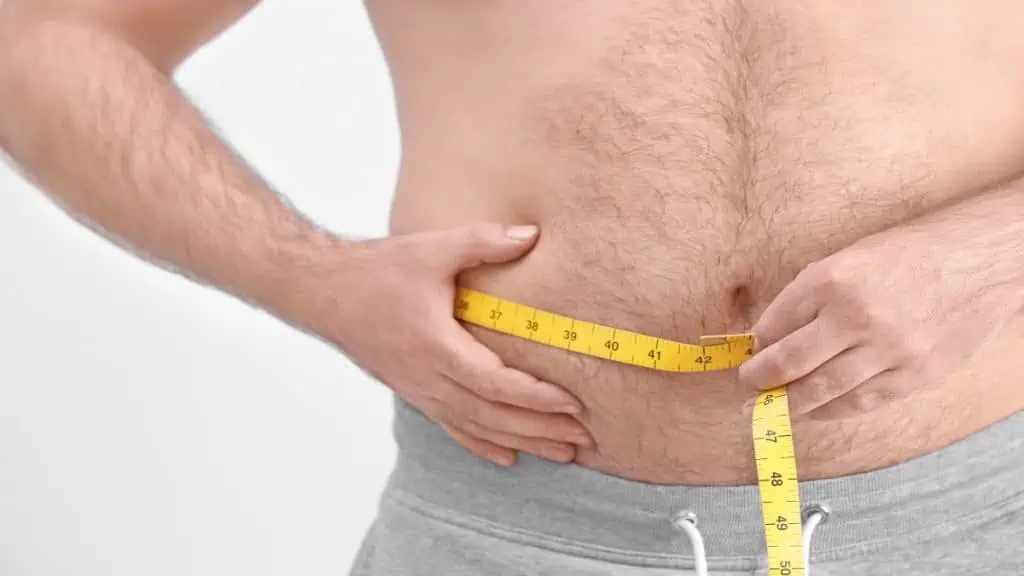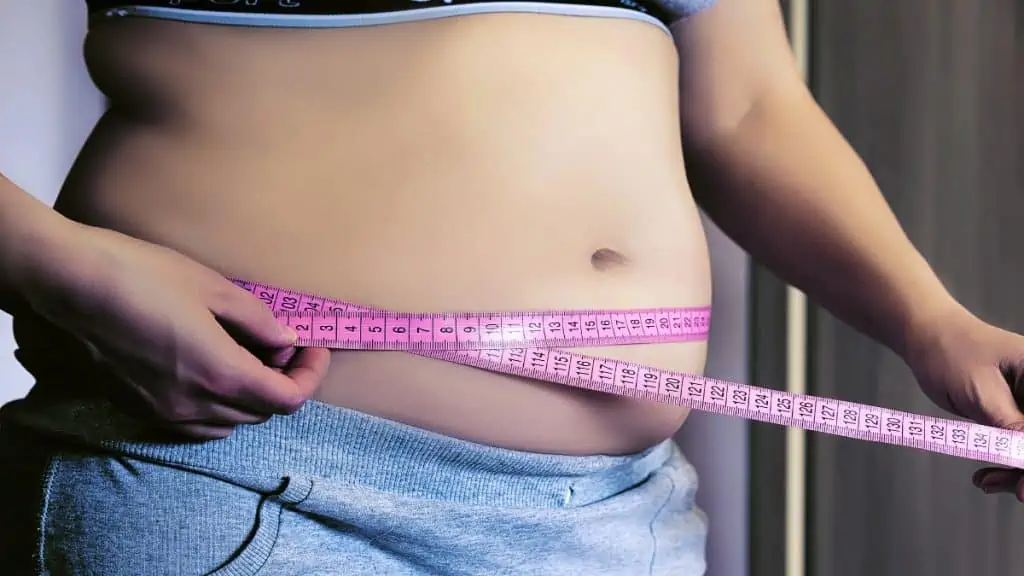While 35 inches definitely isn’t small, it’s still below the average waist size in the United States.
And that’s for both males and females.
As for whether having a 35 inch waist is bad or not, it depends on your height, build, body composition, and gender.
So keep reading to see where you fit in or check out our other articles below for more information on other common waist measurements.
- 30 in waist
- 31 in waist
- 32 in waist
- 33 in waist
- 34 in waist
- 36 in waist
- 37 in waist
- 38 in waist
- 39 in waist
Is a 35 inch waist fat for a woman?

Is a 35 inch waist fat for a woman? Yes, a 35 inch waist is fat for a woman because it’s larger than the 31.5 inch female cut-off point for being considered low risk for chronic diseases like diabetes and cardiovascular disease. [1]
Although 35 inches is actually smaller than average for a woman, based on US anthropometric data, it’s still a large measurement and almost certainly an indicator that you’re living in far from optimal health.
Additionally, other research classifies anything under 35 inches as a normal waist circumference for a woman. [2]
Of course, health isn’t measured in inches. Still, the size of your waistline is a good indicator of your current health status. So you definitely shouldn’t ignore your body and continue down the path of weight gain if your waist is 35 inches.
The good news is that at 35 inches, you’re only a few inches above the lower recommendation.
You can lose belly fat by increasing your activity level and decreasing your calorie intake, both of which help to put your body in an energy deficit, which is a requirement for successful weight loss.
Is a 35 inch waist small for a man?

Is a 35 inch waist small for a man? No, a 35 inch waist definitely is not small for a man. A 35 in waist, in fact, is a medium waist size for males.
Indeed, previously cited research recommends that men keep their waist measurement below 35 inches if they want to maintain good metabolic health.
So while having a 35″ waist isn’t ideal, it’s also not a nightmare measurement, either, because you’ll likely improve your health (and aesthetics) by losing just a couple of inches from your stomach.
While it’s true that most men have a waistline that’s around 5 inches bigger than our 35 inch waist example, that doesn’t necessarily mean that it’s good to only have a 35 inch waistline.
As you’ll learn in just a second, however, there are a few exceptions to the rule.
What does a 35 inch waist look like?

What does a 35 inch waist look like exactly? On a man, a 35 inch waist looks very much average because it’s a medium size.
For a woman, a 35 in waist looks chunky and, although technically smaller than average, likely on the fat side as well.
However, these are just general guidelines. We’re all built differently, and you can certainly look and feel great while having a 35″ waist.
For example, if you’re a weight lifter (especially a taller one) and you have well-developed abs and obliques, then you might actually have a 35 inch stomach while being healthy. This is because growing your abdominal muscles can thicken your waist significantly.
The waist circumference recommendations that you saw in this article are based on the knowledge that visceral fat is dangerous. [3]
Well, muscle mass certainly isn’t the same thing as fat tissue. So it’s highly unlikely that anyone would say that your 35 inch waistline is too big if it’s relatively lean and muscular.
The verdict: Should you slim your 35 inch waistline?

Before embarking on any weight loss regime or diet plan, you should talk to your doctor so that they can assess your current health status.
While the size of your stomach is certainly an indicator of your health, having a small waist is no guarantee that you’ll remain free from disease.
If losing weight and slimming your 35 inch waist is the best course of action for you, then you need to put your body in an energy deficit. This simply means consuming fewer calories than your body needs to maintain its current weight.
Rather than drastically decreasing your food intake, you can also perform cardiovascular exercise and resistance training to burn calories and improve your body composition.
Indeed, you can get your body into an energy deficit (a prerequisite for weight loss) by either eating less or moving more, though most people generally need to do both.
References
- Ardern, C. I., Janssen, I., Ross, R., & Katzmarzyk, P. T. (2004). Development of Health-Related Waist Circumference Thresholds Within BMI Categories. Obesity Research, 12(7), 1094–1103. https://doi.org/10.1038/oby.2004.137
- Ding, M., Markon, A., Wolpert, B., & Chavarro, J. E. (2020). Associations of body mass index and waist circumference with risk of Guillain-Barré syndrome in women and men: A prospective analysis of three cohort studies. PLOS ONE, 15(12), e0239099. https://doi.org/10.1371/journal.pone.0239099
- Mayo Clinic. (2021, March 12). Belly fat in men: Why weight loss matters. https://www.mayoclinic.org/healthy-lifestyle/mens-health/in-depth/belly-fat/art-20045685

